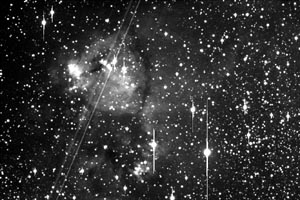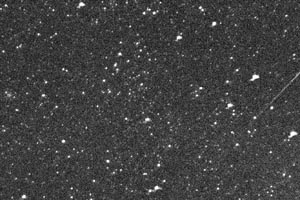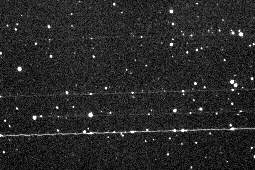
IC1795 with satellite tracks: 30 minute exposure (click to enlarge)
02h 36m 29s RA, 62deg 04min 23sec Decl or at 35deg 34min 51sec azimuth and 49deg 24min 26sec Altitude at the time of the shot.
Note how the satellite tracks are very steady and uniform. Look at the enlargement, and see the additional tracks and the ones that are not parallel.
(Taken on Oct 13, 2001 10:28pm Pacific Daylight Time (0528UTC) Just east of Morgan Hill, Ca. (South of San Jose Ca by about 15 miles))

Orion Area with meteor track (Leonid shower from 11/17/2001)
Note how the meteor "flames out"
![]()
Transient disturbance of a mount while taking a long exposure
Notice how only the bright stars show the disturbance. This is because the time it took for the mount to self-correct was short and only the brightest objects recorded the transient. The core is also bright enough to record the transient, but since it is not a point source of light, the streaking tends to be obscured by the core region being large and diffuse.
This appears to be a satellite track that was caught traversing M1. The slight irregularity of the track may be caused by the satellite tumbling as it reflects the sunlight. This image was taken on Jan 24, 2002 at approximately 0600 UTC from the San Francisco Bay Area. Another shot of M1 with a very similar track was taken by Jack Schmidling of Illinois just days before.
Here's a "confirmation" of it being a satellite from Edward S. Light, who is a frequent posting member of the SeeSat mailing list:
"Using Rob Matson's SkyMap program, a recent alldat file, and an assumed
position of latitude 37.7750 deg N, 122.4183 deg W, I find that at about
22:03.1 PST 01/23/2002 (i.e. 06:03.1 UTC on 1/24), the Raduga 33 satellite
(NORAD 23794, COSPAR 96-010A) passed about a tenth of a degree to the
left of M1, moving slowly to the upper left."

This shot shows several parallel tracks. Unfortunately this is the highest resolution image I have of this shot.